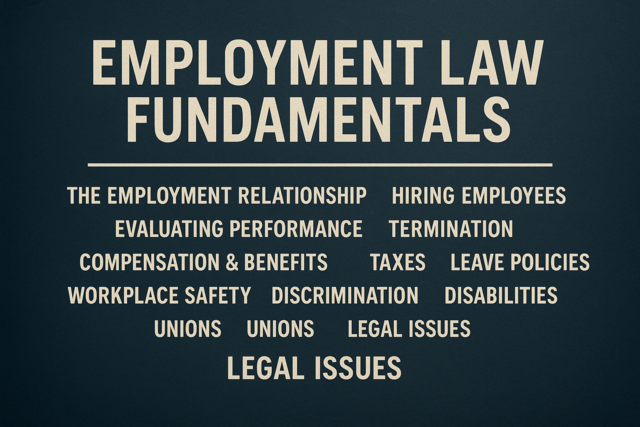Employers must deposit and report employment taxes. Employers who fail to comply with the employment tax filing and deposit rules may be subject to criminal and civil penalties. In 2012, the IRS initiated 148 criminal investigations of businesses suspected of employment tax evasion. They received 92 indictments, and 79 parties were sentenced to an average of 24 months of incarceration. On the whole, the IRS achieved an impressive 81% incarceration rate. Many of the people found guilty were also ordered to pay restitution and fines. Employees also suffer in these circumstances because they may not qualify for social security, Medicare, or unemployment benefits due to their employer's failure to pay the pertinent taxes.
The good news is that you can protect yourself and your business by properly educating yourself and conforming to the IRS requirements.
Employer Identification Number (EIN)
The first step for any business in interacting with the IRS is to obtain an EIN, a nine-digit identification number assigned by the IRS in this format: XX-XXXXXXX. It is used by the IRS to identify the tax account of an employer. A business needs an EIN in order to make tax deposits, record the deposits, and file returns or statements. Use your EIN in all communication with the IRS and the Social Security Administration. You should have only one EIN. If your business has more than one EIN, contact the IRS Business and Specialty Tax Line (800-829-4933; TTY/TDD users can call 1-800-829-4059) to determine which number to use for specific purposes.
Your business must have an EIN if you:
-
Have employees,
-
Have a qualified retirement plan,
-
Operate your business as a corporation or partnership, or
-
File returns for:
-
Employment taxes, or
-
Excise taxes.
-
Applying for an EIN. There are several ways to apply for an EIN:
-
By telephone at 1-800-829-4933. You can obtain an EIN immediately by phone.
-
Online--Click on the EIN link at www.irs.gov/businesses/small. The EIN is issued as soon as the application information is confirmed.
-
By mailing or faxing Form SS-4, "Application for Employer Identification Number." Allow minimally four weeks for mail applications, or at least four business days for faxed applications.
You must file your tax returns and make your deposits on time even if you have not yet received your EIN. If you have not yet received the EIN, write "Applied for" and the date you applied for the number in the space for the EIN. Do not use your social security number as a substitute for the EIN.
IRS Publication 1635 spells out everything you might need to know about the EIN, including business changes that do (e.g., filing bankruptcy under Chapters 7 or 11) or do not (e.g., changing the name or location of the business) require a new EIN: http://www.irs.gov/pub/irs-pdf/p1635.pdf
Change of Address. Use Form 8822-B, "Change of Address--Business," to notify the IRS of an address change. Do not mail this form with your employment tax return
Enrolling to E-file. If you are a new employer and indicate a federal tax obligation when you request your EIN, you will be pre-enrolled in the Electronic Federal Tax Payment System (EFTPS). Your Employer Identification Number (EIN) Package will contain information about Express Enrollment. You will also receive an additional mailing containing your EFTPS personal identification number (PIN) and instructions for activating your PIN. Call the toll-free number located in your "How to Activate Your Enrollment" brochure in order to activate your enrollment. This will enable you to begin making your payroll tax deposits. Don't forget to tell your payroll provider about your EFTPS enrollment.
Examine the Social Security Card of each new employee to ascertain the person's correct name and Social Security Number (SSN). Each employee must also fill out Form I-9 and Form W-4. The employer must report each new hire to the state new hire registry.
Employee Identification. You must obtain an SSN from each employee. Record the name and SSN of each employee exactly as it appears on the employee's Social Security Card. If the employee's name on the card is not correct (e.g., due to marriage or divorce), the employee must request a new card from the Social Security Administration. If the employee does not have an SSN, he or she should file Form SS-5, "Application for a Social Security Card," with the Social Security Administration. This form is available at Social Security Administration offices, by calling 1-800-772-1213, or at the Social Security Administration website: www.ssa.gov. Do not accept an IRS individual taxpayer identification number (ITIN) in place of an SSN. An ITIN is only available to resident and nonresident aliens who are not eligible for U.S. employment. An ITIN is a 9-digit number beginning with the number "9" and either a "7" or "8" as the fourth digit, but it is formatted like an SSN (for example, 9NN-7N-NNNN).
Form I-9. You must verify that each new employee is legally eligible to work in the United States. Both the employer and the employee complete the U.S. Citizenship and Immigration Services (USCIS) Form I-9, "Employment Eligibility Verification." This form is available from USCIS offices or from the USCIS website at www.uscis.gov. If you need additional information about your responsibilities as an employer, you can call USCIS at 1-800-375-5283.
Report All New Hires. Employers are required to report each new employee to a designated state new hire registry. A new employee is an employee not previously employed by you or previously employed by you but separated for at least 60 consecutive days. Many states accept a copy of Form W-4 with the employer information added. More information about this requirement can be found at the Office of Child Support Enforcement website: www.acf.hhs.gov/programs/cse/newhire.
Form W-4. To figure out how much federal income tax to withhold from your employee's wages, you will need to use the employee's Form W-4 and the withholding tables found in IRS Publication 15, "Employer's Tax Guide." Withholding tables change, so be sure to use the most up-to-date tables. Each employee must fill out Form W-4, "Employee's Withholding Allowance Certificate." Use the filing status and withholding allowances shown on this form to calculate the amount of income tax to withhold. Remember that you must deposit the withholdings in a timely fashion. Further information about this form is available in IRS Publication 15. Individual requirements may change from year to year, so be sure to check the updated Publication 15 annually.
Withholding Allowance. In 2013, the amount for one withholding allowance on an annual basis is $3,900.
Employees claiming more than 10 withholding allowances. If an employee claims more than 10 withholding allowances for wages paid, the employer can choose among several methods of withholding, which are detailed in section 16 of IRS Publication 15.
Employer's Responsibility
The IRS provides many helpful tax guides for employers. If you have employees, you should obtain Publication 15, Circular E, "Employer's Tax Guide." (If you have agricultural employees, use instead Publication 51, Circular A, "Agricultural Employer's Tax Guide.")
If you are not sure whether the people working for you are considered employees for tax purposes, see Publication 15-A, "Employer's Supplemental Tax Guide," which will help you determine whether a worker is an employee or an independent contractor. If you misclassify an employee as an independent contractor, you can be held liable for employment taxes for that worker plus a penalty. An independent contractor is someone who is self-employed and retains the right to control the means of accomplishing the work. You do not normally have to withhold or pay any taxes on payments to an independent contractor.
Employers are required by law to withhold employment taxes from their employees. Employers must:
-
Report the income and employment taxes withheld from their employees on Form 941, "Employer's Quarterly Federal Tax Return."
-
Deposit these taxes in full to an authorized bank or financial institution.
-
File a Federal Unemployment Tax Act (FUTA) return (Form 940) annually.
-
Deposit the unemployment taxes.
Federal employment taxes include:
-
Federal income tax withholding
-
Social Security and Medicare taxes
-
Federal unemployment tax (FUTA)
The Federal income tax is known as a "pay as you go" tax, which requires workers to pay the tax as they earn income throughout the year. For most employees, this means income taxes withheld from their paycheck. Self-employed workers are required to make quarterly estimated tax payments during the year because their wages are not subject to withholding. The "pay as you go" system was designed to ensure that taxpayers meet their tax obligations on a timely basis rather than face a large balance due at tax time.
Social Security and Medicare taxes pay for essential benefits that workers and their families receive under the Federal Insurance Contributions Act (FICA). Social Security taxes pay for benefits under the old age, survivors, and disability insurance (OASDI) part of FICA. Medicare taxes pay for hospital benefits. Each employee contributes part of these taxes, and the employer pays a matching amount. (Self-employed taxpayers must also pay Social Security and Medicare taxes in the form of self-employment tax.) The Federal Unemployment Tax Act (FUTA) tax, together with state unemployment tax revenue, provides unemployment compensation to workers who have lost their jobs.
Calculating Taxes. Generally, calculations for wages subject to withholding are based on the employee's gross pay for services performed. This is the total W-2 income before any deductions or exclusions. Such income includes salaries, vacation allowances, housing allowances, bonuses, commissions, and certain fringe benefits. Similarly, wages subject to withholding do not include all types of wages, such as those paid to certain family members, employee 401(k) contributions, sick pay, and selected pre-tax benefits such as flexible spending accounts for medical purposes.
Federal Income Tax. Employers generally must withhold federal income tax from employee wages. You must also, with some exceptions, withhold federal income tax from nonresident alien workers. (For more information on nonresident alien workers, refer to IRS Publication 515, "Withholding of Tax on Nonresident Aliens and Foreign Entities," or section 3 of Publication 51 (Circular A), "Agricultural Employer's Tax Guide," in reference to H-2A visa workers.) To calculate how much federal income tax to withhold from each payment of wages, use the employee's Form W-4 and the methods described in Publication 15.
Social Security and Medicare Taxes. Employers generally must withhold part of the Social Security and Medicare taxes from employee wages, while the employer pays a matching amount. Even if the employee is not subject to withholding for federal income tax, you must still withhold Social Security and Medicare taxes. To calculate how much to withhold from each payment of wages, use the employee's Form W-4 and the methods described in IRS Publication 15 and Publication 15-A. Remember, you must deposit all withheld taxes.
For 2013, the employee tax rate for Social Security increased to 6.2%. The employer tax rate for Social Security continues to be 6.2%. The Social Security wage base limit increased to $113,700.
The Medicare tax rate for 2013 is 1.45% each for the employee and employer. There is no wage base limit for Medicare tax.
You must pay Social Security and Medicare taxes for household workers who receive $1,800 or more in cash or other compensation. Social Security and Medicare taxes also apply to election workers who are paid $1,600 or more in cash or other compensation.
As of January 1, 2013, in addition to withholding Medicare tax at the rate of 1.45%, employers are responsible for withholding a 0.9% Additional Medicare Tax from wages paid to an employee in excess of $200,000 in a calendar year. Begin withholding Additional Medicare Tax in the pay period in which an employee earns wages and compensation in excess of the threshold amount. There is no employer match for the Additional Medicare Tax. Given the high income threshold, few employees are likely to be subject to this additional tax.
Report employment taxes on Form 941, "Employer's Quarterly Federal Tax Return," or Form 944, "Employer's Annual Federal Tax Return." (Farm employers use Form 943, "Employer's Annual Federal Tax Return for Agricultural Employees.") File Form 945, "Annual Return of Withheld Federal Income Tax," if you are required to report backup withholding. You must receive written notice from the IRS to file Form 944.
If you have been filing Form 941, "Employer's Quarterly Federal Tax Return," and have reason to anticipate your employment taxes for the calendar year will be $1,000 or less, and you prefer to file Form 944 instead of Form 941, the rules require you to contact the IRS for permission to file Form 944. You must obtain written authorization from the IRS to file Form 944 instead of Form 941 before using this form. If you have been filing Form 944 but would like to file Form 941 instead, you must ask the IRS for permission and receive written authorization from the IRS. For more information about how to use Form 944 and 941 correctly, go to IRS.gov and enter "file employment taxes annually" in the search box.
Form 941. Each quarter, all employers who pay wages subject to income tax withholding (including withholding on sick pay and supplemental unemployment benefits) or Social Security and Medicare taxes must file Form 941, unless the employer is required to file Form 944 or the following exceptions apply. Do not report more than one calendar quarter on each Form 941. Form 941 must be filed by the last day of the month that follows the end of the quarter.
Form 944. If you receive written notification from the IRS that you qualify for the Form 944 program, you must file Form 944 instead of Form 941. If you received this notification, but prefer to file Form 941, you can request to have your filing requirement changed to Form 941 if you satisfy certain requirements. Employers who must file Form 944 have until the last day of the month that follows the end of the year to file Form 944.
Exceptions:
-
Seasonal employers need not file for quarters when they regularly have no tax liability because they have paid no wages. To alert the IRS you will not have to file a return for one or more quarters, you must check the "Seasonal employer" box on Form 941, line 18. Be sure to also check the box on the top of the form that corresponds to the quarter reported. The IRS will generally not inquire about unfiled returns if at least one taxable return is filed each year. You must check the "Seasonal employer" box on every Form 941 you file, or the IRS will expect a return to be filed for each quarter.
-
Household employers reporting Social Security, Medicare, and/or withheld income tax. If you are a sole proprietor and file Form 941 or Form 944 for business employees, you may include taxes for household employees on your Form 941 or Form 944. Otherwise, you must report Social Security and Medicare taxes and income tax withholding for household employees on Schedule H (Form 1040), "Household Employment Taxes." Further information can be found in IRS Publication 926, "Household Employer's Tax Guide."
-
Employers reporting wages for employees in American Samoa, Guam, the Commonwealth of the Northern Mariana Islands, the U.S. Virgin Islands, or Puerto Rico. If your employees are not subject to U.S. income tax withholding, use Forms 941-SS, 944, or Formulario 944(SP); employers in Puerto Rico use Formularios 941-PR, 944-SP, or Form 944. If you have both employees who are subject to U.S. income tax withholding and employees who are not subject to U.S. income tax withholding, you must file only Form 941 (or Form 944 or Formulario 944-SP) and include all employee wages on that form.
-
Agricultural employers. Use Form 943, "Employer's Annual Federal Tax Return for Agricultural Employees."
Correcting Form 941 or Form 944 or Claiming a Refund. Make corrections to a previously filed Form 941 or Form 944 by using Form 941-X, "Adjusted Employer's Quarterly Federal Tax Return or Claim for Refund," or Form 944-X, "Adjusted Employer's Annual Federal Tax Return or Claim for Refund."
Do not file more than one Form 941 per quarter or more than one Form 944 per year. Employers with multiple locations or divisions must file only one Form 941 per quarter or one Form 944 per year.
Form 941 or 944 e-file. You can electronically file Form 941 or Form 944. More information can be found at http://www.irs.gov/uac/e-file-for-Business-and-Self-Employed-Taxpayers, or call 1-866-255-0654.
Penalties. In addition to any penalties, interest accrues from the due date of the tax on any unpaid balance.
-
For each whole or partial month that a return is not filed when required (apart from extensions of the filing deadline), there is a failure-to-file penalty of 5% of the unpaid tax due with that return. The maximum penalty is generally 25% of the tax due.
-
For each whole or partial month the tax is paid late (apart from extensions of the payment deadline), there is a failure-to-pay penalty of 0.5% per month of the amount of tax. The maximum amount of the failure-to-pay penalty is also 25% of the tax due.
-
If both penalties apply in any month, the failure-to-file penalty is reduced by the amount of the failure-to-pay penalty.
-
The penalties will not be charged if the IRS agrees you have "reasonable cause" for failing to file or pay. If you receive a penalty notice, you are entitled to provide an explanation of why you believe reasonable cause exists.
-
For individual filers only, the failure-to-pay penalty is reduced to 0.25% per month if an installment agreement is in effect. You must have filed your return on or before the due date of the return to qualify for the reduced penalty.
-
If income, Social Security, or Medicare taxes are not withheld or are not deposited, you may be personally liable for the trust fund recovery penalty.
-
Use of a reporting agent or other third-party payroll service provider does not relieve an employer of the responsibility to ensure that tax returns are filed and all taxes are paid or deposited correctly and on time. Be sure to thoroughly investigate third-party services before using them.
Final return. If you go out of business, you must file a final return for the last quarter (last year for Form 944) in which wages are paid. If you continue to pay wages or other compensation for periods following termination of your business, you must file returns for those periods. You are also required to furnish Forms W-2 to your employees by the due date of your final return. File Forms W-2 and W-3 with the SSA by the last day of the month that follows the due date of your final return.
Federal Unemployment (FUTA) Tax
The federal unemployment tax is part of the federal and state program under the Federal Unemployment Tax Act (FUTA), which pays unemployment compensation to workers who lose their jobs. You report and pay FUTA tax separately from Social Security and Medicare taxes and withheld income tax. The amount of the FUTA tax is based on the employee's wages, but employees do not pay this tax or have it withheld from their pay. The employer alone pays FUTA tax from the business' funds. Report federal unemployment tax on Form 940, "Employer's Annual Federal Unemployment (FUTA) Tax Return."
Non-employee Payees
If you make reportable payments to a person who is not an employee, you will need that person's SSN. If you make reportable payments to an organization, such as a corporation or partnership, you will need its EIN. You can obtain the payee's SSN or EIN by using Form W-9, "Request for Taxpayer Identification Number and Certification," which is available from IRS offices by calling 1-800-829-3676, or at the IRS website: IRS.gov.
If the payee does not provide you with an identification number, you may still have to withhold part of the payments as backup withholding.
Making and Reporting Deposits
Deposit Schedules. There are two deposit schedules, monthly and semi-weekly. Before the beginning of each calendar year, you must determine which of the two deposit schedules you are required to use. If you fail to make a timely deposit, you may be subject to a 10% penalty.
FUTA Deposits. Deposits for FUTA Tax (Form 940) are required for the quarter within which the tax due exceeds $500. The tax must be deposited by the end of the month following the end of the quarter. For example, if the tax is for the quarter ending in April, the tax must be deposited by the end of May.
Deposit Due Dates. Employment tax due dates are located at http://www.irs.gov/Businesses/Small-Businesses-&-Self-Employed/Employment-Tax-Due-Dates.
E-deposits. You must use electronic funds transfer to make all federal tax deposits. Electronic fund transfers can be made using the Electronic Federal Tax Payment System (EFTPS). You can pay any tax due to the IRS through EFTPS. Alternatively, you can arrange for your tax professional, financial institution, payroll service, or other trusted third party to make electronic deposits on your behalf. You may also arrange for your financial institution to initiate a same-day wire payment on your behalf. Whereas EFTPS is a free service of the Department of Treasury, other services may charge a fee. You must be enrolled in EFTPS to use it; you can enroll by visiting? www.eftps.gov, or calling 1-800-555-4477. Once the information you enter on the website is validated, it takes five to seven days business days to receive a PIN. Once you are enrolled, payments can also be made through an EFTPS voice response system: 800-555-3453. Further information about EFTPS is available in IRS Publication 966, "Electronic Federal Tax Payment System: A Guide To Getting Started."
Deposit Record. An Electronic Funds Transfer (EFT) Trace Number will be provided with each successful payment. The number can be used as a receipt or to trace the payment.
Timely Deposits. EFTPS provides the option of scheduling payments in advance. For deposits using EFTPS to be on time, you must initiate the deposit by 8 p.m. Eastern time the day before the deposit is due. If a third party is making the deposit on your behalf, that party may have earlier cutoff times. You are responsible for timely payment even if the EFTPS website is down. In that eventuality, use the voice response system instead: 800-555-3453.
Electronic Funds Withdrawal (EFW). If you file Form 940, Form 941, or Form 944 electronically, you can e-file and e-pay (through electronic funds withdrawal) the balance due in a single step using tax preparation software or through a tax professional. Do not use EFW to make federal tax deposits. For more information on paying your taxes using EFW, visit www.irs.gov/e-pay. A fee may be charged to file electronically.
Credit or Debit Card Payments. For information on paying your taxes with a credit or debit card, go to www.irs.gov/e-pay. Do not use credit or debit cards to make federal tax deposits.
Same-day Payment Option. In the unlikely event that you neglect to initiate an electronic deposit transaction on EFTPS by 8 p.m. Eastern time the day before the due date, you may still be able to make your deposit in timely fashion by using the Federal Tax Application (FTA). To use the same-day payment method, you must make advance arrangements with your financial institution. Please check with your financial institution regarding availability, deadlines, and costs. For additional details regarding this option, visit www.eftps.gov to download the Same-Day Payment Worksheet.
Deposit Penalties
Penalties may apply if you do not make required deposits on time or if you make deposits for less than the required amount. The penalty rates range from 2% to 15% of the amount due and increase depending on how many days past due the deposits are made. The IRS may also assess an "averaged" failure-to-deposit (FTD) penalty of 2% to 10% for making mistakes. The trust fund recovery penalty may be imposed on any individual determined by the IRS to be responsible for collecting, accounting for, and paying over these taxes, and who willfully failed to do so.
The penalties do not apply if the failure to make the deposit was due to reasonable cause and not willful neglect. The IRS may also waive penalties if you inadvertently fail to deposit in the first quarter you were required to deposit any employment tax, or in the first quarter during which your frequency of deposits changed, if you filed your employment tax return in a timely fashion.
If the business fails to make deposits or file returns, it may receive written notice from the IRS requiring that taxes be deposited into a special trust account for the U.S. Government. Failure to comply with the special bank deposit requirements may result in criminal charges.
Order in which deposits are applied. The IRS will generally apply deposits to the most recent tax liability within the quarter. If you receive a failure-to-deposit penalty notice, you are entitled to designate how your deposits are to be applied in order to minimize the amount of the penalty, but you must do so within 90 days of the date of the notice. The penalty notice will contain instructions. For more information about how to designate deposits, review Revenue Procedure 2001-58 on page 579 of Internal Revenue Bulletin 2001-50 at www.irs.gov/pub/irs-irbs/irb01-50.pdf.
After the end of the calendar year, you must provide copies of Form W-2, "Wage and Tax Statement," to each employee you paid wages during that year. You must also send copies to the Social Security Administration. (For instructions on e-filing Form W-2 with the Social Security Administration, go to www.socialsecurity.gov/employer.)
Employment Tax Evasion Schemes
A quick way to get in trouble with the IRS is by falling for one of the many employment tax evasion schemes that people may tell you will work. These schemes do not work. Only by following IRS guidelines will you keep your business and yourself safe and in compliance. Among the more prevalent methods of employment tax evasion are pyramiding, employee leasing, paying employees in cash, filing false payroll tax returns, or failing to file payroll tax returns.
Pyramiding of employment taxes is a dangerous practice in which a business withholds taxes from its employees but intentionally fails to remit them to the IRS. Businesses involved in pyramiding frequently file for bankruptcy to discharge the liabilities accrued and then start a new business under a different name and begin a new scheme. In such circumstances, the IRS has the right to assess a "responsible person" the withheld federal income tax and Social Security taxes. This is known as the "Trust Fund Recovery Penalty" and is generally nondischargeable in bankruptcy.
Employee Leasing is a legal business practice that is sometimes abused. Employee leasing is the practice of contracting with outside businesses to handle all administrative, personnel, and payroll concerns for employees. Sometimes employee-leasing companies fail to pay the IRS any portion of the collected employment taxes. These taxes are often spent by the owners on business or personal expenses. Often the company dissolves, leaving millions in employment taxes unpaid. Let the business owner beware: the business that hires the outside provider remains responsible for the unpaid taxes! There are instances when the IRS has refused to grant the business penalty relief in such cases, despite the damaging outcome. The best way to avoid such problems is to check carefully for references before engaging an outside service in this capacity, and by maintaining a fidelity bond or other protection against such losses.
Paying Employees in Cash, either wholly or partially, is a common method of evading income and employment taxes. It results in lost tax revenue to the government and the loss or reduction of future Social Security or Medicare benefits for the employee.
Filing False Payroll Tax Returns or Failing to File Payroll Tax Returns. Understating wages or failing to file employment tax returns are other methods commonly used to evade employment taxes. These methods are dealt with harshly by both the IRS and state taxing authorities.
State Employment Tax
State Employment Tax Requirements follow rules similar to those governing the federal employment tax system. An employer must withhold and timely remit state income tax, and file a state withholding tax return. Like the IRS, state taxing authorities may assess penalties for failure to file a timely return or failure to remit tax. In addition, most states have the power to assess a "responsible person" individually for withheld taxes not remitted. Typically, this refers to a controller, officer, majority owner, or someone similarly situated with the power to direct the flow of company funds. Each state's employment tax system is different, so it is wise to check the rules before paying employees. Typically, states require the reporting and remittance of income taxes withheld, in addition to unemployment tax, which is paid solely by the employer. Rates and rules vary by state.






























